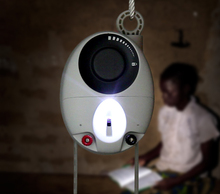Many groups are working to bring light to the roughly 1 billion people in the developing world that live without it.
We usually hear about solar lighting being used to help people replace kerosene, which is not only expensive but highly polluting, posing health and fire risks.
Another kind of innovative concept is under development by two British designers, who have worked with the likes of Toshiba, NEC and TomTom. Their lamp, called the GravityLight, gets its energy from a weight suspended on a cord below it.
Like an old grandfather clock, the light simply relies on weights. A weighted bag pulls on a gear train attached to a DC motor (see the photo below). As gravity pulls the weight down, the light is illuminated.

Each cycle lasts 30 minutes. To "recharge" the light, you rehang the weight again.
Designers Martin Riddiford and Jim Reeves say the GravityLight is much cheaper and more reliable than using solar panels. They have been working on the idea for the past four years in their free time.
"Lower cost self-contained lamps are becoming more widely available, but batteries are the weak link, because they are expensive and deteriorate through use and over time," they write on the Indiegogo Web site, where they are raising money to mass produce the lights. "Very often, when buying a low cost solar lamp with an inbuilt rechargeable battery, a full third of what you’re paying for is the battery, and you will need to replace it every few years. Assuming you can get a new battery… The capacity is often reduced to save money which limits the use time, after which there is no light."
Riddiford and Reeves are hoping to get the price of each light down to around $5. The money raised through their IndieGogo crowdfunding campaign will go toward lights that will be distributed in Africa. The two have already more than tripled their original fund-raising goal of $55,000 and there is still about a month left.
It is worth noting that both of them were involved with SolarAid, an organization that is seeking to eliminate kerosene lamps in Africa by 2020 using solar-powered alternatives. They believe solar will be a more viable option over time.
Read more about the GravityLight project:

I want one. Sell these for $10-$15 to Western consumers like me and use the money to finance your company and provide lights to third world citizens.
what is the output of the generator?
need you to scale it up so i can boil a quart of water,can that be done? any ideas on a green solution for boil water, other than solar?